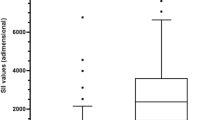Abstract
Objective
To identify the factors that facilitate the diagnosis of pediatric appendicitis.
Methods
Institutionally approved retrospective, single center analysis of all patients with acute abdominal pain was done. Medical history, symptoms, laboratory and radiologic findings of all children presenting with abdominal pain were evaluated. To identify the best predictors, uni- and multi-variate analysis were used.
Results
In 2 years, 431 patients fulfilled the inclusion criteria. Data was complete in all subjects. Of these, 156 (36.2 %) suffered from appendicitis. The best discriminators for appendicitis were clinical and ultrasound features. The four best factors were identified by CART analysis (continuous abdominal pain, tenderness on the right lower quadrant, rebound tenderness and conspicuous ultrasound) and combined to the Heidelberg Appendicitis score. A positive score (>3 features) is highly predictive for acute appendicitis (PPV 89.3 %, NPV 94.9 %) and includes all cases of perforated appendicitis.
Conclusions
It is possible to predict acute appendicitis in children. The decision making process can be simplified by the proposed Heidelberg Appendicitis score, which is comprised of four factors. It has great potential to facilitate and accelerate the diagnosis of pediatric appendicitis.
Similar content being viewed by others
Abbreviations
- WBC :
-
White blood count
- CRP :
-
C-reactive protein
- US :
-
Ultrasound
- CT :
-
Computerised tomography
- SD :
-
Standard deviation
- CART :
-
Classification and regression tree analysis
- OR :
-
Odds ratio
- CI :
-
Confidence intervals
- PPV :
-
Positive predictive value
- NPV :
-
Negative predictive value
- PAS :
-
Pediatric appendicitis score
References
Flum DR, Koepsell T. The clinical and economic correlates of misdiagnosed appendicitis: nationwide analysis. Arch Surg. 2002;137:799–804; discussion 804.
Becker T, Kharbanda A, Bachur R. Atypical clinical features of pediatric appendicitis. Acad Emerg Med. 2007;14:124–9.
Karakas SP, Guelfguat M, Leonidas JC, Springer S, Singh SP. Acute appendicitis in children: comparison of clinical diagnosis with ultrasound and ct imaging. Pediatr Radiol. 2000;30:94–8.
Aspelund G, Fingeret A, Gross E, et al. Ultrasonograph/MRI versus CT for diagnosing appendicitis. Pediatrics. 2014;133:586–93.
Cheong LH, Emil S. Outcomes of pediatric appendicitis: an international comparison of the United States and Canada. JAMA Surg. 2014;149:50–5.
Miglioretti DL, Johnson E, Williams A, et al. The use of computed tomography in pediatrics and the associated radiation exposure and estimated cancer risk. JAMA Pediatr. 2013;167:700–7.
Flum DR, Morris A, Koepsell T, Dellinger EP. Has misdiagnosis of appendicitis decreased over time? A population-based analysis. J Am Med Assoc. 2001;286:1748–53.
Tzanakis NE, Efstathiou SP, Danulidis K, et al. A new approach to accurate diagnosis of acute appendicitis. World J Surg. 2005;29:1151–6; discussion 7.
Terrin N, Schmid CH, Griffith JL, D'Agostino RB, Selker HP. External validity of predictive models: a comparison of logistic regression, classification trees, and neural networks. J Clin Epidemiol. 2003;56:721–9.
Samuel M. Pediatric appendicitis score. J Pediatr Surg. 2002;37:877–81.
Alvarado A. A practical score for the early diagnosis of acute appendicitis. Ann Emerg Med. 1986;15:557–64.
Lintula H, Pesonen E, Kokki H, Vanamo K, Eskelinen M. A diagnostic score for children with suspected appendicitis. Langenbeck's Arch Surg/Deutsche Gesellschaft fur Chirurgie. 2005;390:164–70.
Kulik DM, Uleryk EM, Maguire JL. Does this child have appendicitis? A systematic review of clinical prediction rules for children with acute abdominal pain. J Clin Epidemiol. 2013;66:95–104.
Andersson RE. Meta-analysis of the clinical and laboratory diagnosis of appendicitis. Br J Surg. 2004;91:28–37.
Yang HR, Wang YC, Chung PK, Chen WK, Jeng LB, Chen RJ. Laboratory tests in patients with acute appendicitis. ANZ J Surg. 2006;76:71–4.
Kwan KY, Nager AL. Diagnosing pediatric appendicitis: Usefulness of laboratory markers. Am J Emerg Med. 2010;28:1009–15.
Scheinfeld MH, Mahadevia S, Stein EG, Freeman K, Rozenblit AM. Can lab data be used to reduce abdominal computed tomography (CT) usage in young adults presenting to the emergency department with nontraumatic abdominal pain? Emerg Radiol. 2010;17:353–60.
Contributions
MB: Conceptualized and designed the study, acquired the data, drafted the initial manuscript, and approved the final manuscript as submitted; TB: Conceptualized and designed the study, acquired the data, and approved the final manuscript as submitted; PG: Conceptualized and designed the study, approved the final manuscript as submitted and will act as guarantor for the paper. All authors approved the final manuscript as submitted and agree to be accountable for all aspects of the work.
Author information
Authors and Affiliations
Corresponding author
Ethics declarations
Conflict of Interest
None.
Source of Funding
None.
Additional information
Michael Boettcher and Thomas Breil contributed equally to this work.
Rights and permissions
About this article
Cite this article
Boettcher, M., Breil, T. & Günther, P. The Heidelberg Appendicitis Score Simplifies Identification of Pediatric Appendicitis. Indian J Pediatr 83, 1093–1097 (2016). https://doi.org/10.1007/s12098-016-2106-2
Received:
Accepted:
Published:
Issue Date:
DOI: https://doi.org/10.1007/s12098-016-2106-2




